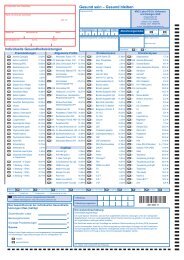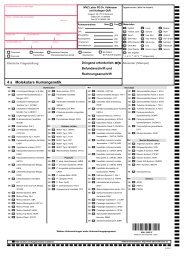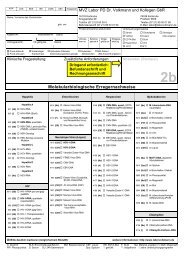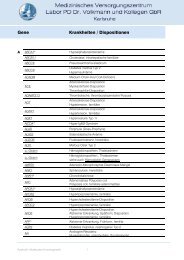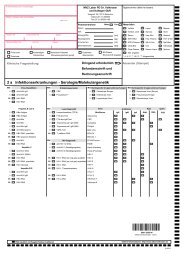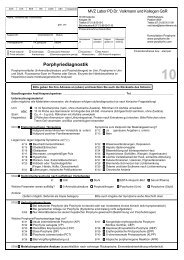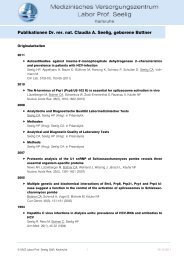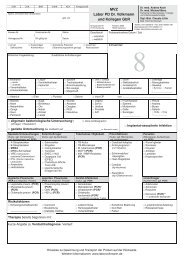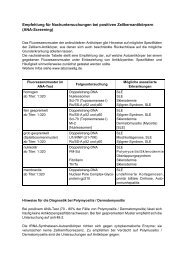ORIGINAL ARTICLE - MVZ Labor PD Dr. Volkmann und Kollegen
ORIGINAL ARTICLE - MVZ Labor PD Dr. Volkmann und Kollegen
ORIGINAL ARTICLE - MVZ Labor PD Dr. Volkmann und Kollegen
You also want an ePaper? Increase the reach of your titles
YUMPU automatically turns print PDFs into web optimized ePapers that Google loves.
Clin. Lab. 9+10/2011<br />
AUTOANTIBODIES AGAINST IM<strong>PD</strong>H2 AND HCV INFECTION<br />
Figure 3. a: SDS-Page of His(6)-tag-IM<strong>PD</strong>H2 (lane A) and 35 S-methionine labeled IM<strong>PD</strong>H2 synthesized by in vitro translation/<br />
transcription (lane B) for purity assessment (lane M = molecular weight markers). Lanes 1 – 9 depict His(6)-tag-IM<strong>PD</strong>H2<br />
blotted on nitrocellulose and reacted with control sera of three healthy blood donors (lanes 1-3), serum of a HCV-RNA positive<br />
patient with negative immunofluorescence staining (lane 4), serum of index patient (lane 5), serum of a HCV-RNA positive patient<br />
showing an immunofluorescence pattern suspicious of anti-IM<strong>PD</strong>H2 (lane 6), rabbit anti-IM<strong>PD</strong>H2 ih (lane 7), rabbit anti-<br />
IM<strong>PD</strong>H2 Si (lane 8), and rabbit anti His(6)-tag (lane 9). The purity of the His(6)-tag-IM<strong>PD</strong>H2 (lane A) is >95 %. Whereas the<br />
reaction of the index patient (lane 5) is rather strong, the reaction with the other IIFT positive patient (lane 6) is rather weak.<br />
ih = in house, Si = Sigma.<br />
b: Line blots containing four lines of 4, 8, 16, and 32 ng spotted His(6)-tag-IM<strong>PD</strong>H2 respectively and reacted with serum of a<br />
blood donor (lane 1), serum of the index patient (lane 2), and sera of HCV-RNA positive patients showing an immunofluorescence<br />
pattern suspicious for anti-IM<strong>PD</strong>H2 (lanes 3 – 6). The control line contains spotted anti-human IgG. Only the index patient<br />
reacts with the spotted His(6)-tag-IM<strong>PD</strong>H2. No reaction was seen with the 4 other sera, also containing anti-IM<strong>PD</strong>H2 as<br />
demonstrated by RIPA (Figure 4).<br />
tive in IIFT as well as in RIPA.<br />
The disparity of the reaction strength of His(6)-tag-IM-<br />
<strong>PD</strong>H2 with the serum of the index patient and that of<br />
IIFT and HCV-RNA positive patients increased considerably<br />
when using line blots. Whereas an unchanged<br />
strong reaction was revealed by the index patient (Figure<br />
3b, lane 2), neither the four HCV-RNA positive sera<br />
detected by immunofluorescence (lanes 3 – 6) nor any<br />
one of the other 104 HCV-RNA containing sera reacted<br />
with spotted IM<strong>PD</strong>H2 in line blots.<br />
The disappointing results obtained with western and<br />
line blots prompted the design of a RIPA using 35 S-methionine<br />
labeled IM<strong>PD</strong>H2 produced by in vitro transcription/translation.<br />
Using this kind of antigen not only<br />
the index patent’s serum but also the four HCV-RNA<br />
positive sera, depicted in Figure 3b (lanes 3 - 6) as well<br />
759<br />
as the two rabbit sera (anti-IM<strong>PD</strong>H2Si, anti-IM<strong>PD</strong>H2ih)<br />
precipitated 35 S-metionine-IM<strong>PD</strong>H2 in a dose dependent<br />
manor (Figure 4). This data strongly suggests that<br />
the RIPA is more suitable for anti-IM<strong>PD</strong>H2 screening<br />
in human sera than western or line blots. A summary of<br />
the reactivity of the various antigens with human sera<br />
and rabbit antibodies <strong>und</strong>er different test conditions is<br />
given in Table 1.<br />
High prevalence of anti-IM<strong>PD</strong>H2 in HCV-RNA carriers<br />
To evaluate the prevalence of anti-IM<strong>PD</strong>H2 in HCV-<br />
RNA carriers, 108 HCV-RNA positive sera were<br />
screened by RIPA and compared with sera of patients<br />
negative for HCV-RNA, patients suffering from HBV<br />
infections, autoimmune liver disease, and autoimmune



